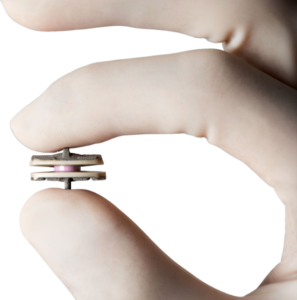Patented Cervical Artificial Disc Revolutionizes Spinal Injury Recovery

A new medical device called Simplify® recently received approval from the U.S. Food and Drug Administration (FDA). This device is a cervical artificial disc meant to serve as an implant for people who whose existing cervical disc have become too narrow, causing pain in their spinal cord. This implant is placed into a patient’s spine through cervical disc arthroplasty, which originally began to be practiced by physicians in the 1960s. Since its inception, this procedure has seen many improvements in terms of the technology utilized and improvement towards the health and mobility of patients. Most recently with the FDA approval of Simplify®, patients can expect improved mobility of their spine and an implant that is better suited for their anatomy.
The human cervical spine is made up of seven bones (known as cervical vertebrae) stacked up on top each other from the neck down to the shoulders. These bones are separated by cervical discs, that serve as cushions for the bones to prevent shock during movement, promote full range of motion, and allow the spinal cord to travel from the brain to the spine. Over time, it is very common for the discs of a person’s cervical spine to wear out and need replacement via a cervical disc arthroplasty. This phenomenon can occur due to the age of patients and the natural wear and tear of the human body. The cervical disc replacement procedure is done because when the discs wear out, they can cause a lot of pain by hitting any respective nerves during any movement of the neck area. During cervical disc arthroplasty, the worn-out disc is removed and replaced with an artificial disc. Before the 1960s when this surgery first became medical practice, surgeons would remove the worn-out disc and fuse the upper and lower cervical vertebrae together. This was problematic because it would prevent any mobility after surgery for patients.
Although major progress was made in the 1960s with the first prosthetic for cervical disc arthroplasties, there was still a lot of troubleshooting that occurred to get us to where we are today. The first implant was made of stainless-steel and although it brought initial success, it was discontinued due to its various associated complications in patients after surgery. Newer iterations of implants were not begun to be developed until the 1980s. European doctors tried to make additions to the original stainless-steel design by making it more mobile with added screws and a ball-and-socket feature, but this was also deemed unsatisfactory by patients. This drew physicians and scientists to reimagine the functionality and design of the cervical disc implant. In 2002, a reimagined design was created and tested, showing much more promising results than previous renditions of the implant. Alterations to this same design were implemented and FDA approved in 2014, allowing for the replacement of multiple discs at a time, something that was unconceivable in the past.
The Simplify® cervical artificial disc was first invented and patented in 2017 (US10166113B2) by Malan de Villiers and Ulrich Hahnle under Simplify®Medical. This device features multiple additions meant to increase comfort and mobility in patients. It is made up of three individual pieces combined: a dual opposed articulation, a self-centering core, and a retention ring. Part of it’s innovative qualities stem from it’s twelve different sizes meant to adjust to various types of patients and their anatomies. Another innovative feature is the material used to make the implant. The upper and lower plates are made up of polyetheretherketone (PEEK) and titanium plasma coating, with the core of the device being composed of ceramic materials. This feature was implemented in order to reduce the presence of metallic debris in the body of patients. This has been noted to be more biologically compatible with the human body, improving the outcomes of patients’ post-operation. This implant can also be detected by MR imaging, allowing for physicians to check the status of patient’s cervical spine after surgery to ensure there are no complications. Some of the other features of this implant include wider range of mobility for patients due to its three-piece design as well as being available in three different heights to accommodate varying neck lengths. So far, the Simplify® cervical disc has been the only of its kind to show lack of degradation (wearing of cervical discs) in patients throughout the first 24 months of implantation.
This incredible medical device received FDA approval in April of 2021 and has the potential to dramatically change the lives of patients suffering from cervical spinal issues.
https://www.medicaldevicepatentattorneys.com/2021/12/patented-cervical-artificial-disc-revolutionizes-spinal-injury-recovery/trackback/

